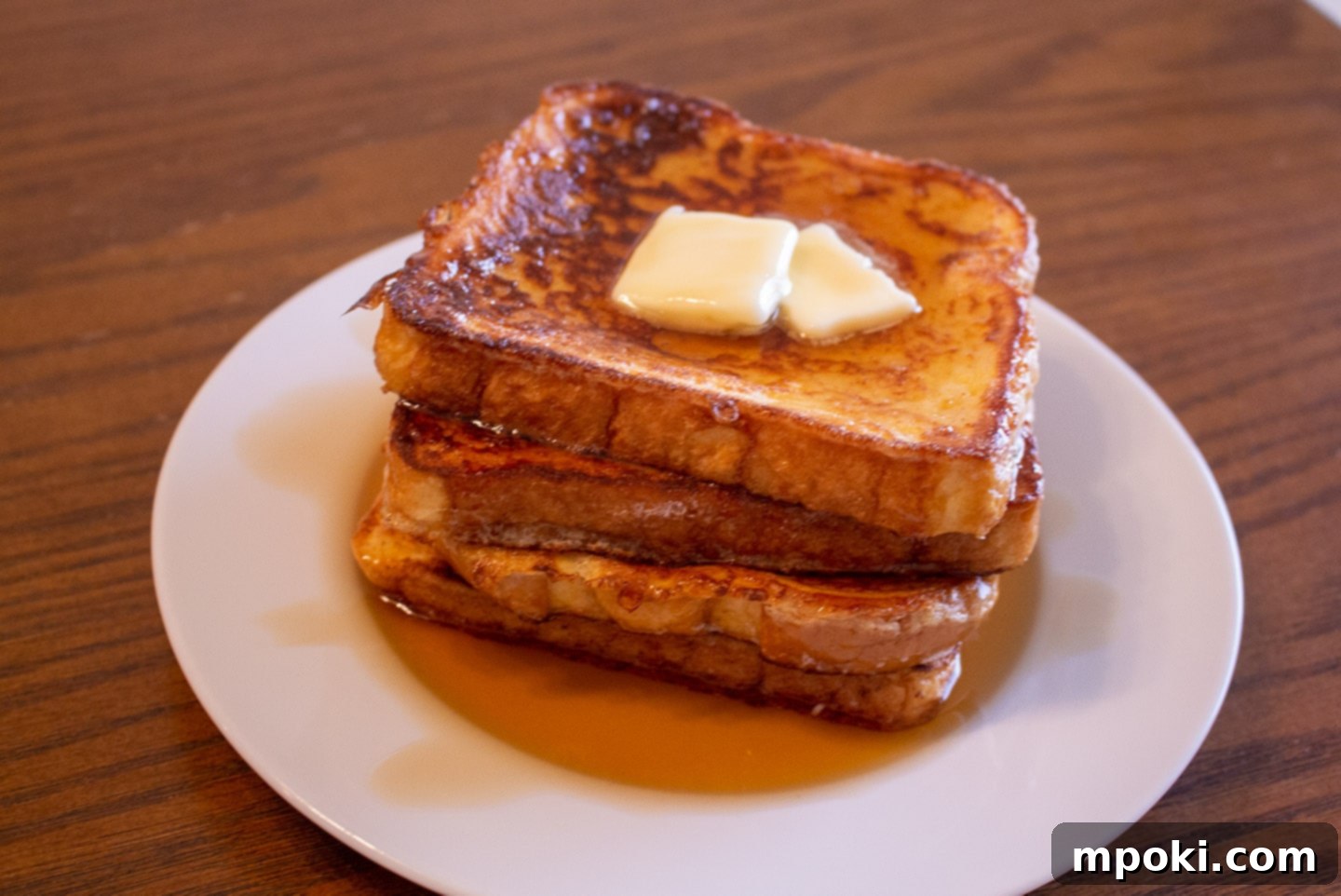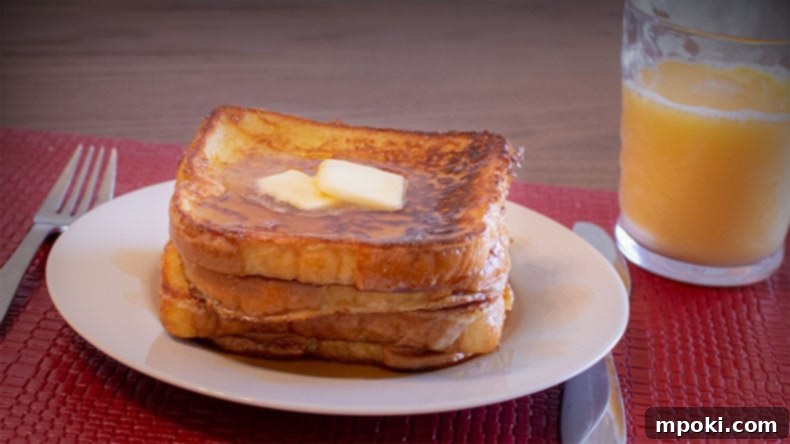Mastering French Toast: The Ultimate Guide to Perfectly Golden and Crispy Slices
Do you yearn for French toast that transcends the ordinary? Not just “okay” French toast, but the kind that’s perfectly golden, irresistibly crispy on the outside, and delightfully tender on the inside? If so, then “Dad Got This” is your definitive guide to breakfast perfection. Forget soggy slices or uncooked egg bits clinging stubbornly to your bread; Dad has unearthed the number one secret trick, along with essential insights, to elevate your French toast game to an entirely new level.
French toast, at its heart, seems like a straightforward dish – merely bread, eggs, dairy, and a few optional extras. Yet, despite its apparent simplicity, it’s remarkably easy to go wrong. Many home cooks grapple with French toast that emerges from the pan either disappointingly soggy or marred by unsightly streaks of undercooked egg. But fear not! With the wisdom shared in this comprehensive guide, those frustrations will become a distant memory. Prepare to transform your breakfast routine and impress everyone with your newfound French toast mastery.
PIN IT TO PINTEREST
Save this easy recipe to Pinterest for later!
This Page Contains Affiliate Links. For more Information See My Disclosures here.
The #1 Game-Changing Secret: Ditch the Butter, Embrace the Oil!
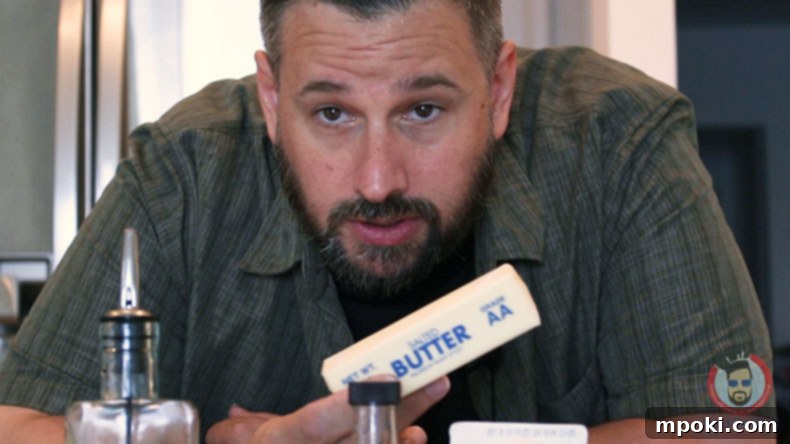
This single tip is arguably the most crucial piece of advice you will take away from this guide to making extraordinary French toast. It’s time to break free from convention and stop using butter in your pan or griddle. Instead, reach for good old vegetable oil. Your taste buds, and your family, will undoubtedly thank Dad for this revelation.
The key to achieving that coveted, beautifully browned crust on your French toast lies in getting your cooking surface adequately hot. A hot pan ensures a rapid, even sear, locking in moisture while developing a delicious exterior. Unfortunately, butter, with its low smoke point, is simply not up to this task. When subjected to high heat, butter breaks down quickly, burning and turning brown before your French toast has a chance to develop its desired crust. This results in an acrid, burnt flavor and an unevenly cooked surface.
If you attempt to circumvent butter’s propensity to burn by lowering the heat, you’ll encounter a different problem: an extended cooking time that prevents the formation of any crust at all. This prolonged, low-heat cooking is precisely how you end up with French toast that is disappointingly soggy and lacks textural appeal.
By contrast, using a neutral-flavored vegetable oil (such as canola, grapeseed, or standard vegetable oil) allows you to heat your cooking surface to the ideal temperature without the worry of burning. Oil boasts a significantly higher smoke point than butter, meaning it can withstand the heat necessary to achieve a perfect, golden-brown crust in a matter of minutes. This enables your French toast to cook quickly and evenly, ensuring a crispy exterior and a tender, moist interior every single time. It’s a simple switch that makes an enormous difference.
Elevate Your Experience: Invest in an Electric Griddle
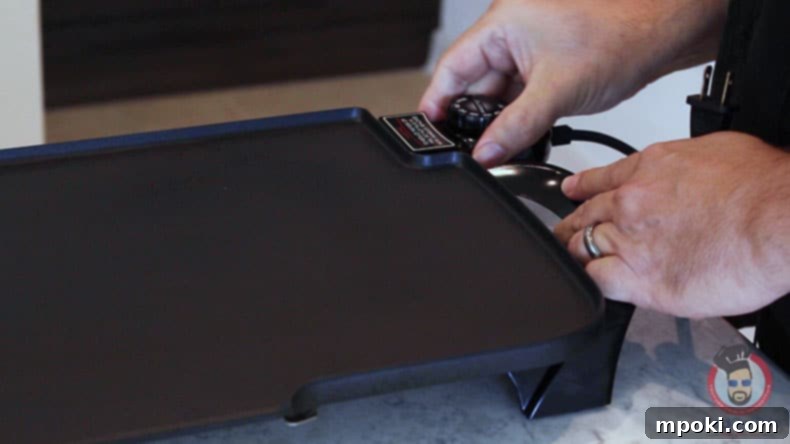
Speaking of the ideal cooking surface, Dad highly recommends you consider acquiring an Electric Griddle. While a standard non-stick pan can work, an electric griddle offers several significant benefits that will dramatically improve your French toast-making process and results. It’s an investment that pays dividends in perfectly cooked breakfast foods.
The first and most immediately apparent benefit of an electric griddle is the sheer amount of cooking space it provides. Say goodbye to cooking one or two slices at a time on a cramped stovetop pan! An electric griddle offers ample room for multiple slices of bread, allowing you to prepare breakfast for the whole family much more efficiently. But beyond mere capacity, this extra space serves a crucial culinary purpose: it allows you to flip your French toast to a *new, fresh section* of the cooking surface.
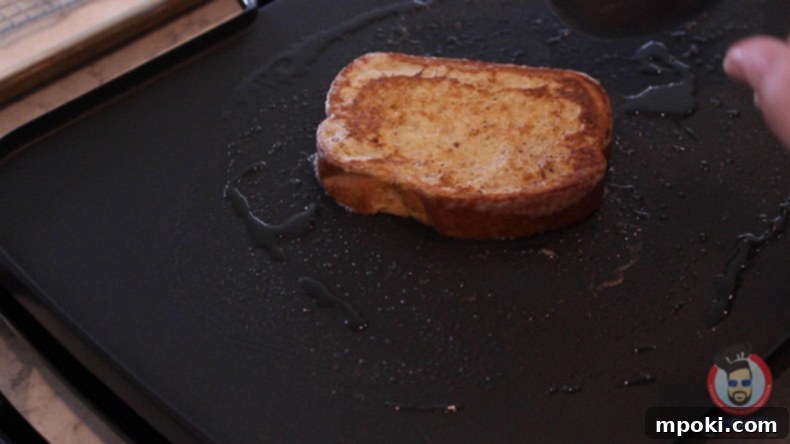
Why is flipping your French toast to a new section of the cooking surface so important? When any food item is placed on a hot surface, it inevitably draws heat away, causing the temperature of that specific spot to drop. If you flip your French toast directly back onto the same cooled spot, the second side will not experience the same initial burst of heat as the first. This often results in one side being beautifully browned and crispy, while the other remains pale and undercooked. By strategically flipping each slice to a fresh, fully preheated section of the griddle, you ensure that both sides receive consistent, high heat. This guarantees an even, golden-brown crust and a perfectly cooked interior on every single piece.
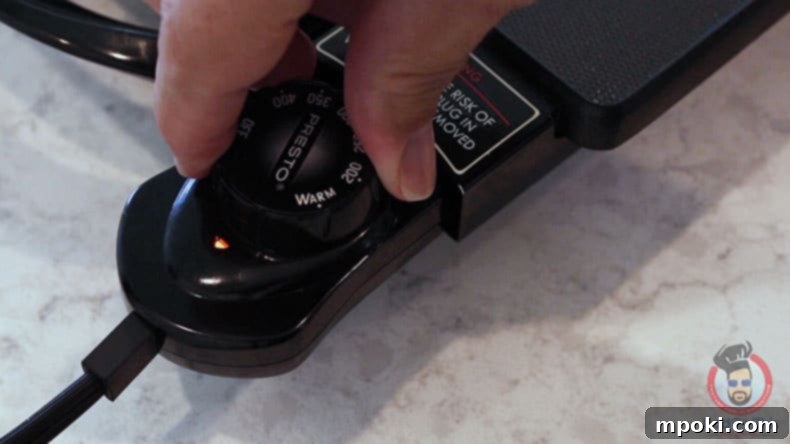
Finally, and perhaps most critically for consistent results, an Electric Griddle offers significantly more precise control over the heat. Unlike stovetop burners, which can fluctuate in temperature and often have hot spots, an electric griddle maintains a steady, even temperature across its entire surface. This precise control translates directly into better, more repeatable results for your French toast.
Numerous factors can influence the ideal cooking temperature, including the thickness and type of bread, the exact consistency of your egg mixture, and even environmental variables like elevation and humidity (yes, we’re getting a bit “geeky” here, but these details matter!). For example, Dad might find 390°F to be the sweet spot, but for your specific setup, 375°F could be what yields perfectly browned and cooked French toast. The beauty of an electric griddle is the ability to dial in that precise temperature and replicate it consistently, batch after batch, ensuring French toast perfection every time.
The Golden Ratio: Achieving the Perfect Egg-to-Liquid Balance

Beyond the crucial step of using oil instead of butter, the next most important factor in achieving Instagram-worthy French toast is striking the correct egg-to-liquid ratio in your batter. This balance is critical for texture and flavor.
If your mixture contains too little liquid relative to the eggs, you’ll end up with a dense, overly eggy creation that more closely resembles an omelet clinging to bread than true French toast. It will lack that delicate, custard-like interior. Conversely, if there’s too much liquid, the mixture becomes diluted, and you lose that rich, custardy “eggy” flavor that defines great French toast. The bread might also become excessively soggy and fall apart during cooking.
Dad has perfected his ratio: two large eggs for every ⅓ cup of liquid. This proportion creates a rich, flavorful batter that coats the bread beautifully without oversaturating it. And speaking of liquid, Dad highly recommends using heavy cream, just as he does in his recipe. Heavy cream contributes an unparalleled richness and silkiness to the French toast, resulting in a more decadent and satisfying experience. While milk can certainly be used, it simply won’t yield the same luxurious texture or depth of flavor. For an extra touch of indulgence and the best possible outcome, heavy cream is the way to go.
The Ultimate French Toast Recipe: Your Journey to Breakfast Perfection
This recipe combines Dad’s essential tips with a simple ingredient list to help you make the best French toast you’ve ever tasted. It’s an easy-to-follow process with a few crucial tweaks that make all the difference.
Equipment
- Electric Griddle (highly recommended for best results) or a large non-stick skillet
- Mixing bowl
- Whisk
- Shallow dish (for dipping bread)
- Spatula
- Wire cooling rack (optional, but recommended to prevent sogginess)
Ingredients
- 4 slices Bread (brioche, challah, or thick-cut white bread work best)
- 2 Large Eggs
- ⅓ cup Heavy Cream (or milk, if preferred)
- 1 teaspoon Vanilla Extract
- 1 teaspoon Ground Cinnamon
- 4 tablespoons Vegetable Oil (or other high smoke point oil like canola, grapeseed – Estimate)
- Optional Toppings: Maple syrup, powdered sugar, fresh berries, whipped cream
Instructions
- Prepare the Griddle: Preheat your Electric Griddle to 390°F (approximately 199°C). If using a non-stick pan, place it over medium-high heat and allow it to get hot. A hot surface is crucial for a crispy crust.
- Whisk the Eggs: Crack the two large eggs into a mixing bowl.
- Add Liquid: Pour in the ⅓ cup of heavy cream.
- Introduce Flavor: Add the vanilla extract and ground cinnamon to the mixture. For an extra kick, a tiny pinch of nutmeg can also be added.
- Mix Thoroughly: Whisk all the ingredients together vigorously until the mixture is completely smooth and no streaks of egg white remain. This ensures an even coating and no “white bits” on your French toast.
- Prepare Dipping Station: Pour the egg mixture into a shallow dish, such as a pie plate or a large Tupperware container, making it easy to dip your bread.
- Dip the Bread: Take one slice of bread and gently place it into the egg mixture. Allow it to soak for about 10-15 seconds per side, ensuring it’s fully coated but not oversaturated. You want it moist, not dripping.
- Add Oil to Griddle: Lightly coat your preheated griddle or pan with about 1 tablespoon of vegetable oil. You want a thin, even layer.
- Cook the French Toast: Carefully place the dipped bread onto the hot, oiled cooking surface. If using an electric griddle, you can place multiple slices. Cook for 2-3 minutes per side, or until a beautiful golden-brown crust forms. Remember, flipping a little early is better than late; you can always flip it back for more browning, but you can’t reverse a burn!
- Flip to a Fresh Spot (Griddle Only): If using an electric griddle, when you flip the French toast, move it to a new, fresh section of the griddle that hasn’t cooled down. This ensures even cooking and browning on both sides.
- Serve or Cool: Once your French toast has achieved a delightful golden-brown crust on both sides, serve immediately with your favorite toppings. If you’re cooking a large batch and not serving right away, transfer the cooked slices to a wire cooling rack to prevent them from becoming soggy. You can briefly reheat them on the griddle or pan before serving.
- Enjoy Your Creation: Marvel at your perfectly crafted French toast and savor every bite!
Pro Tips for French Toast Success
- Choose the Right Bread: While any bread works, thicker, sturdier breads like brioche, challah, Texas toast, or even slightly stale sourdough absorb the batter without falling apart and give a great texture. Day-old bread is often preferred as it’s slightly drier and absorbs more batter.
- Don’t Overcrowd: Whether using a griddle or a pan, avoid overcrowding the cooking surface. Give each slice ample space to cook evenly and to allow for easy flipping.
- Keep Warm: If cooking multiple batches, preheat your oven to a low temperature (around 200°F or 90°C) and place cooked French toast on a wire rack set over a baking sheet to keep warm and crisp.
- Experiment with Flavors: Beyond vanilla and cinnamon, consider adding a pinch of nutmeg, a dash of almond extract, or a little orange zest to your batter for different flavor profiles.
Video: How to Make the Best French Toast
Nutrition Information (Per Serving, Estimated)
Calories: 1186 kcal | Carbohydrates: 61g | Protein: 24g | Fat: 96g | Saturated Fat: 66g | Cholesterol: 436mg | Sodium: 737mg | Potassium: 385mg | Fiber: 6g | Sugar: 8g | Vitamin A: 1641IU | Calcium: 281mg | Iron: 6mg
Frequently Asked Questions About Perfect French Toast
What is the best type of bread for French toast?
The best breads for French toast are those that are slightly dense and sturdy, capable of absorbing the batter without becoming overly soggy or falling apart. Brioche, challah, and Texas toast are popular choices due to their rich flavor and thick slices. Slightly stale bread is actually ideal, as its drier texture allows for better absorption of the egg mixture.
How do I prevent my French toast from becoming soggy?
Several factors contribute to soggy French toast. Firstly, ensure your cooking surface (griddle or pan) is hot enough before placing the bread – this creates a quick seal and crust. Secondly, use oil instead of butter for higher heat cooking. Thirdly, avoid oversaturating the bread in the batter; a quick, even dip is usually sufficient. Finally, if cooking in batches, transfer cooked French toast to a wire cooling rack rather than stacking them, as stacking traps steam and makes them soggy.
Can I make French toast ahead of time?
While French toast is best enjoyed fresh off the griddle, you can prepare it ahead of time. Cooked French toast can be stored in an airtight container in the refrigerator for 2-3 days or frozen for up to a month. To reheat, you can use a toaster, oven (at 350°F/175°C for 5-10 minutes), or briefly on the griddle until warmed through and re-crisped.
Why do my French toast slices have uncooked egg on them?
Uncooked egg bits are usually a sign that your egg mixture wasn’t thoroughly whisked. Ensure you whisk the eggs and liquid vigorously until no distinct streaks of egg white or yolk are visible. The mixture should be a uniform color and consistency. Also, make sure your cooking surface is adequately hot, as too low a temperature can prevent the egg from setting properly.
Dad truly hopes you give his perfected French toast recipe a try. He loves hearing from his readers and getting feedback on his culinary creations. So, once you’ve experienced the magic of crispy, golden, and perfectly flavored French toast, be sure to let him know!
Tried this recipe?Mention @DadGotThis or tag #DadGotThis!
